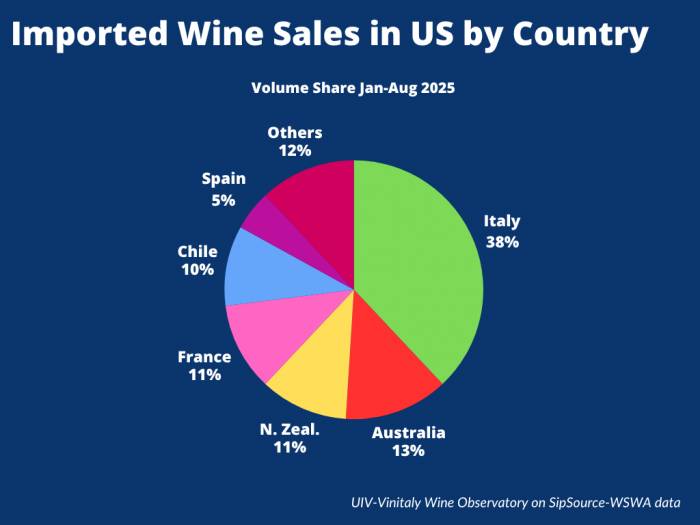Italian Wine Exports Drive $10 Billion Impact in the U.S. Economy
Italian wine exports generated over $2.2 billion in 2024, underscoring their global importance
2025-10-06

The second edition of Vinitaly.USA opened in Chicago, bringing together key players in the wine business at Navy Pier for two days of meetings, tastings, and discussions. The event, held on October 5 and 6, aims to strengthen the economic and cultural ties between Italy and the United States through the promotion of Italian wine. According to data from the Uiv-Vinitaly Observatory, Italian wine exports to the U.S. generated over $2.2 billion in annual revenue for Italian companies in 2024. However, the total value created for American partners is much higher, exceeding $10 billion each year.
Federico Bricolo, president of Veronafiere, emphasized that Italian wine is not only a symbol of gastronomic excellence but also a strategic economic asset in relations between Italy and the United States. He explained that Vinitaly.USA was created as a platform to focus on business, dialogue, and collaboration to protect and promote this heritage in a challenging market environment.
The U.S. remains the largest export market for Italian wine, accounting for 24% of Italy’s total wine exports by value. In 2024, imports of Italian wine into the U.S. reached nearly $2.3 billion, with 354 million liters sold—the equivalent of more than 470 million standard bottles. Italian labels hold a 38% share among foreign wines consumed in the U.S., far ahead of competitors from Australia, New Zealand, France, and Chile.
Despite domestic wines making up about 70% of all wine consumed in the United States, Italian wines have carved out a leading position among imports. Every dollar spent on Italian or European wine generates an estimated $4.50 in value for the American economy, according to the Uiv-Vinitaly Observatory. This multiplier effect highlights a commercial relationship that has developed over more than half a century.
The impact of Italian wine extends beyond importers and distributors. The U.S. is home to more than 1,000 registered wine importers—many specializing in Italian and European wines—alongside an equal number of distributors and wholesalers and about 2,000 retailers. The Italian restaurant industry alone is valued at $95 billion annually and includes over 62,000 businesses nationwide. Italian wines are central to these establishments’ offerings; Prosecco appears on 41% of American menus according to research by Italian Wine Podcast and Somm.ai, while Tuscan reds are also highly sought after.
The broader economic footprint is significant. The “2025 Economic Impact Report” by Wine America estimates that the total annual impact of wine in the United States—direct, indirect, and induced—is $144.4 billion. Of this amount, nearly $19 billion is attributed to Italian wine alone.
This year’s Vinitaly.USA comes at a sensitive time for the sector due to new tariffs of 15% imposed since August on imported wines. Both American distributors and trade groups such as WSWA and the U.S. Wine Trade Alliance have voiced concerns about these tariffs’ effects on business.
Representatives from Coldiretti and Filiera Italia attended Vinitaly.USA to highlight not only well-known denominations but also lesser-known varieties that showcase Italy’s biodiversity—Italy boasts 570 native grape varieties across 681,000 hectares of vineyards. Luigi Scordamaglia of Coldiretti stressed during his remarks that moderate consumption of quality wine is part of the Mediterranean Diet—a point recently recognized by a United Nations document—and distinguished this from harmful alcohol abuse.
Organizers see Vinitaly.USA as an opportunity to reinforce awareness about responsible consumption and to promote authentic Made in Italy products at a time when global markets are changing rapidly. They argue that Italian wine exports represent not just a product but a lifestyle that cannot be easily replicated or imitated elsewhere.
For many American consumers and businesses, Italian wine has become more than just an import—it is an integral part of dining culture and economic activity across the country. As challenges such as tariffs arise, both sides are working to ensure that this longstanding partnership continues to thrive in an evolving global marketplace.
Founded in 2007, Vinetur® is a registered trademark of VGSC S.L. with a long history in the wine industry.
VGSC, S.L. with VAT number B70255591 is a spanish company legally registered in the Commercial Register of the city of Santiago de Compostela, with registration number: Bulletin 181, Reference 356049 in Volume 13, Page 107, Section 6, Sheet 45028, Entry 2.
Email: [email protected]
Headquarters and offices located in Vilagarcia de Arousa, Spain.